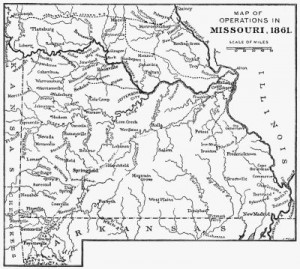This month the First Colored Baptist Church of East St. Louis is established on Carr Island in the Mississippi River, straddling the line between Missouri and Illinois. The church is set apart from the city, reflecting the distance that yet remains among whites and blacks in much of the North.
Carr Island is a local name given to a tract of land that at high tide is cut off from the mainland.
Years after the war, the “island” is thus described:
A tract of land known as “Carr Island” lies along the Mississippi river, In St. Clair county. This so-called Island is separated from the mainland by a depression or slough, known as “Carr slough,” which at a time of high water, in a state of nature, becomes an arm of the Mississippi river, water from the river flowing into it at the north end and emptying out of it at the south end Into the river. It also carries away surface water falling east of It and surface water falling on the eastern portion of Carr Island.
Humble though the church may be, members rejoice that they are free to worship God autonomously, according to the dictates of their own conscience and the leading of the Spirit as they perceive. The congregation calls Rev. J. Martin as their first pastor.
Decades following the war the church is renamed Macedonia Baptist Church. In 1929 the congregation moves to the East St. Louis mainland, constructing a building at the corner of Fourteenth and Broadway.
By the time of the 1929 move, East St. Louis is an industrial city with large populations of African Americans and European immigrants. In the late 20th century, the city becomes predominantly African American.
The Macedonia Baptist church yet remains a thriving congregation at Fourteenth and Broadway.
Sources: Erica Van Buren, “Macedonia Baptist celebrates 150 years,” St. Louis American, 2013 (link); Tim Fox, editor, Where We Live: A Guide to St. Louis Communities, St. Louis: Missouri Historical Society Press, 1995, p. 91 (link); Macedonia Baptist Church (link); The Northeastern Reporter, Volume 80, St. Paul: West Publishing, 1907, p. 880 (link); East St. Louis, Illinois (link)



